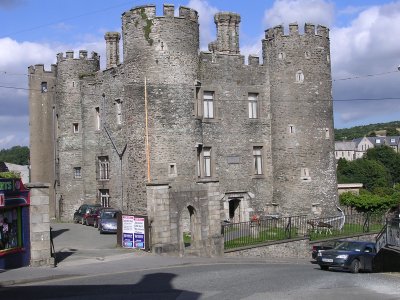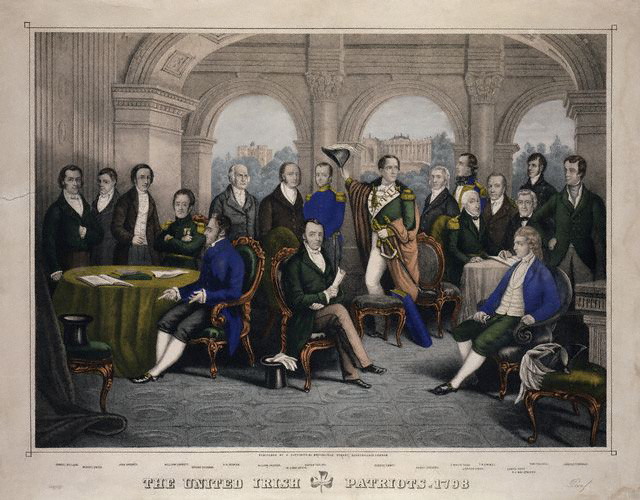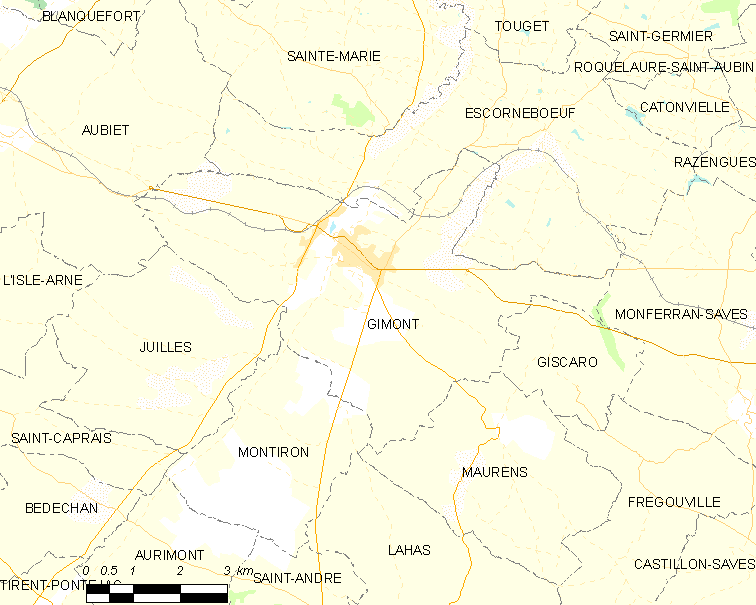|
Enniscorthy
Enniscorthy () is the second-largest town in County Wexford, Republic of Ireland, Ireland. The town is located on the picturesque River Slaney and in close proximity to the Blackstairs Mountains and Ireland's longest beach, Curracloe. The Placenames Database of Ireland sheds no light on the origins of the town's name. It may refer either to the "Island of Corthaidh" or the "Island of Rocks". The cathedral of the Roman Catholic Diocese of Ferns is located in the town as well as an array of other historical sites such as Enniscorthy Castle and the key battle site of the Irish Rebellion of 1798, 1798 Rebellion. At the 2022 census of Ireland, 2022 census, the population of the urban area of Enniscorthy was 12,310. The town is twinned with Gimont, France. History Enniscorthy Castle Enniscorthy Castle is an imposing Norman stronghold, which dates from 1205 and was a private dwelling until 1951. The castle was built by the DePrendergasts. In the early 1580s, the poet Edmund Spense ... [...More Info...] [...Related Items...] OR: [Wikipedia] [Google] [Baidu] |
Enniscorthy Castle, March 17 2024
Enniscorthy () is the second-largest town in County Wexford, Ireland. The town is located on the picturesque River Slaney and in close proximity to the Blackstairs Mountains and Ireland's longest beach, Curracloe. The Placenames Database of Ireland sheds no light on the origins of the town's name. It may refer either to the "Island of Corthaidh" or the "Island of Rocks". The cathedral of the Roman Catholic Diocese of Ferns is located in the town as well as an array of other historical sites such as Enniscorthy Castle and the key battle site of the 1798 Rebellion. At the 2022 census, the population of the urban area of Enniscorthy was 12,310. The town is twinned with Gimont, France. History Enniscorthy Castle Enniscorthy Castle is an imposing Norman stronghold, which dates from 1205 and was a private dwelling until 1951. The castle was built by the DePrendergasts. In the early 1580s, the poet Edmund Spenser leased the property that included the castle. The castle was also ... [...More Info...] [...Related Items...] OR: [Wikipedia] [Google] [Baidu] |
County Wexford
County Wexford () is a Counties of Ireland, county in Republic of Ireland, Ireland. It is in the Provinces of Ireland, province of Leinster and is part of the Southern Region, Ireland, Southern Region. Named after the town of Wexford, it was based on the historic Gaelic Ireland, Gaelic territory of Uí Ceinnselaig, Hy Kinsella (''Uí Ceinnsealaigh''), whose capital was Ferns, County Wexford, Ferns. Wexford County Council is the Local government in the Republic of Ireland, local authority for the county. The population of the county was 163,527 at the 2022 census. History The county is rich in evidence of early human habitation.Stout, Geraldine. "Essay 1: Wexford in Prehistory 5000 B.C. to 300 AD" in ''Wexford: History and Society'', pp 1 – 39. ''Portal tombs'' (sometimes called dolmens) exist at Ballybrittas (on Bree Hill) and at Newbawn – and date from the Neolithic period or earlier. Remains from the Bronze Age period are far more widespread. Early Irish tribes formed ... [...More Info...] [...Related Items...] OR: [Wikipedia] [Google] [Baidu] |
Battle Of Vinegar Hill
The Battle of Vinegar Hill (''Irish language, Irish'': ''Cath Chnoc Fhíodh na gCaor'') was a military engagement during the Irish Rebellion of 1798 on 21 June 1798 between a force of approximately 13,000 government troops under the command of Gerard Lake, 1st Viscount Lake, Gerard Lake and 16,000 Society of United Irishmen, United Irishmen rebels led by Anthony Perry. The battle, a major rebel defeat, took place on 21 June 1798 on a large rebel camp on Vinegar Hill and in the streets of Enniscorthy, County Wexford and marked the last major attempt by the rebels to hold and control territory taken in Wexford. Background By 18 June 1798, a government force led by Gerard Lake, 1st Viscount Lake, Gerard Lake and numbering roughly 13,000-strong had surrounded County Wexford and were ready to march into the county and suppress the Irish Rebellion of 1798, rebellion. Local Society of United Irishmen, United Irishmen commanders issued a call for all rebels in the county to gather at ... [...More Info...] [...Related Items...] OR: [Wikipedia] [Google] [Baidu] |
Vinegar Hill Windmill
Vinegar Hill Windmill or Templeshannon Windmill is a tower mill on Vinegar Hill, Enniscorthy, County Wexford. History Vinegar Hill Windmill is a small-scale circular single-bay, single-stage windmill, dating from between 1600 and 1798. It sits on a piece of elevated ground, and is of a brick and dressed stone construction. The windmill was the command centre for the Irish rebel camp during the 1798 Rebellion The Irish Rebellion of 1798 (; Ulster-Scots: ''The Turn out'', ''The Hurries'', 1798 Rebellion) was a popular insurrection against the British Crown in what was then the separate, but subordinate, Kingdom of Ireland. The main organising force ... on Vinegar Hill, and they flew their banner from the windmill. When the rebels were defeated by General Gerald Lake on 21 June 1798, the banner was replaced with the English Royal Standard. Current use It has been in ruins since before 1840, and most likely fell into disuse after the 1798 Rebellion. The windmill is curr ... [...More Info...] [...Related Items...] OR: [Wikipedia] [Google] [Baidu] |
Irish Rebellion Of 1798
The Irish Rebellion of 1798 (; Ulster Scots dialect, Ulster-Scots: ''The Turn out'', ''The Hurries'', 1798 Rebellion) was a popular insurrection against the British Crown in what was then the separate, but subordinate, Kingdom of Ireland. The main organising force was the Society of United Irishmen. First formed in Belfast by Presbyterianism, Presbyterians opposed to the landed Protestant Ascendancy, Anglican establishment, the Society, despairing of reform, sought to secure a republic through a revolutionary union with the country's Catholic Church, Catholic majority. The grievances of a rack-rented tenantry drove recruitment. While assistance was being sought from the French First Republic, French Republic and from democratic militants in Britain, martial-law seizures and arrests forced the conspirators into the open. Beginning in late May 1798, there were a series of uncoordinated risings: in the counties of County Carlow, Carlow and County Wexford, Wexford in the southeast ... [...More Info...] [...Related Items...] OR: [Wikipedia] [Google] [Baidu] |
1798 Rebellion
The Irish Rebellion of 1798 (; Ulster-Scots: ''The Turn out'', ''The Hurries'', 1798 Rebellion) was a popular insurrection against the British Crown in what was then the separate, but subordinate, Kingdom of Ireland. The main organising force was the Society of United Irishmen. First formed in Belfast by Presbyterians opposed to the landed Anglican establishment, the Society, despairing of reform, sought to secure a republic through a revolutionary union with the country's Catholic majority. The grievances of a rack-rented tenantry drove recruitment. While assistance was being sought from the French Republic and from democratic militants in Britain, martial-law seizures and arrests forced the conspirators into the open. Beginning in late May 1798, there were a series of uncoordinated risings: in the counties of Carlow and Wexford in the southeast where the rebels met with some success; in the north around Belfast in counties Antrim and Down; and closer to the capital, Du ... [...More Info...] [...Related Items...] OR: [Wikipedia] [Google] [Baidu] |
Wexford Rebellion
The Wexford Rebellion refers to the events of the Irish Rebellion of 1798 in County Wexford. From 27 May until 21 June 1798, Society of United Irishmen rebels revolted against British rule in the county, engaging in multiple confrontations with Crown forces. The most successful and destructive rising in all the counties of Ireland, United Irishmen rebels experienced a number of early successes in the county despite being seen as a relatively loyal county by the Dublin Castle administration due to a series of military victories. However, the tide soon turned against the United Irishmen in Wexford as Crown forces poured into the region, engaging in a brutal counterinsurgency which indiscriminately targeted suspected rebels and eventually suppressed all rebel activities in the county. Background The County Wexford branch of the Society of United Irishmen had remained relatively intact during the government repression by the Dublin Castle administration which saw neighbouring ... [...More Info...] [...Related Items...] OR: [Wikipedia] [Google] [Baidu] |
Gimont
Gimont (; ) is a Communes of France, commune in the Gers Departments of France, department in southwestern France. It is about west of Toulouse. It is the seat (capital) of the canton of Gimone-Arrats. Geography The commune is bordered by seven other communes: Escornebœuf to the north, Monferran-Savès to the northeast, Giscaro to the east, Maurens, Gers, Maurens to the southeast, Montiron to the south, Juilles to the west, and finally by Aubiet to the northwest. Population International relations Gimont is twinned with Enniscorthy in Ireland. See also *Communes of the Gers department References Communes of Gers {{Gers-geo-stub ... [...More Info...] [...Related Items...] OR: [Wikipedia] [Google] [Baidu] |
Eircode
A postal address in Ireland is a place of Delivery (commerce), delivery defined by Irish Standard (IS) EN 14142-1:2011 ("Postal services. Address databases") and serviced by the universal service provider, . Its addressing guides comply with the guidelines of the Universal Postal Union (UPU), the United Nations-affiliated body responsible for promoting standards in the postal industry, across the world. In Ireland, 35% of premises (over 600,000) have non-unique addresses due to an absence of house numbers or names. Before the introduction of a national postcode system (Eircode) in 2015, this required postal workers to remember which family names corresponded to which house in smaller towns, and many townlands. , An Post encourages customers to use Eircode because it ensures that their post person can pinpoint the exact location. Ireland was the last country in the OECD to create a postcode system. In July 2015 all 2.2 million residential and business addresses in Ireland r ... [...More Info...] [...Related Items...] OR: [Wikipedia] [Google] [Baidu] |
Henry Wallop
Sir Henry Wallop (c. 1540 – 14 April 1599) was an English statesman. Biography Henry Wallop was the eldest son of Sir Oliver Wallop (d. 1566) of Farleigh Wallop in Hampshire. His younger brother William Wallop was thrice mayor of Southampton. Due to primogeniture, he inherited the estates of his father and of his uncle, Sir John Wallop. He was knighted in 1569 and was chosen member of parliament for Southampton in 1572. His connection with Ireland, began in 1579, when he was appointed vice-treasurer of that country. This position was a very thankless and difficult one and Wallop appears to have undertaken it unwillingly. However, Sir Henry reached Dublin and was soon immersed in the troubles caused by the rebellion of Gerald FitzGerald, 15th Earl of Desmond, finding, in his own words, it was "easier to talk at home of Irish wars than to be in them". In July 1582, he and Adam Loftus, archbishop of Dublin, were appointed Lord Justices for Ireland. They were responsible f ... [...More Info...] [...Related Items...] OR: [Wikipedia] [Google] [Baidu] |








